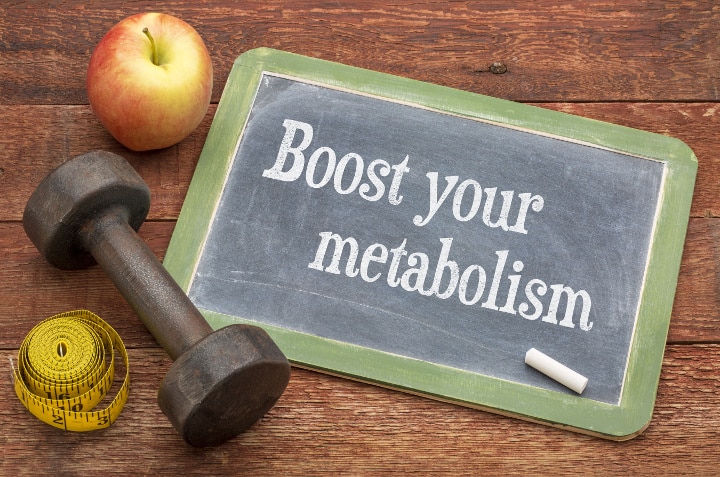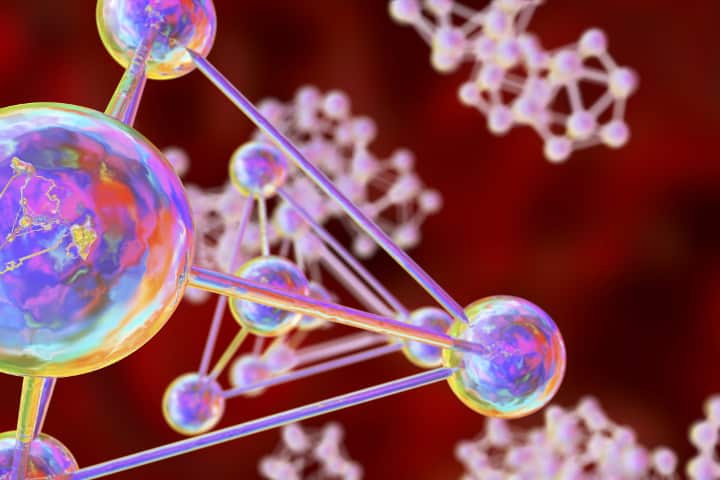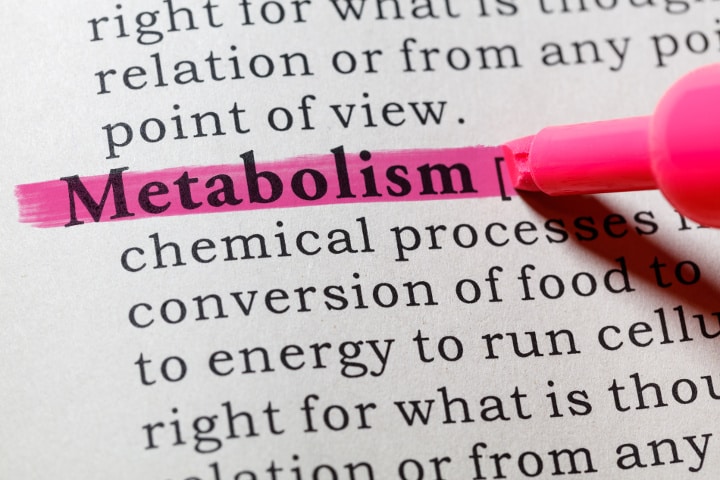The Ultimate Guide to Fast Metabolism (and How to Get It)

Whether you heard about metabolism in a high school gym class or conversations about diet and fitness, you probably know that there’s a link between metabolism and weight.
But, you’re probably wondering:
How does metabolism actually work? Is it possible to change your metabolism? Or is a fast metabolism just something you either have or you don’t?
Let’s make one thing clear up front: It is possible to change your metabolism.
In this article, you will learn strategies to increase your metabolism so you can lose weight or maintain a healthy weight. You’ll also learn how metabolism functions, what causes slow metabolism, and how to recognize signs that your metabolism isn’t operating at top speed.
Let’s get started by looking at how metabolism keeps your body moving.
Curious if hypnosis could help you lose weight?
Take our hypnotizability test and find out!
What Is Metabolism?
Metabolism is the process through which your body uses energy—or calories—to keep your systems functioning. In other words, your metabolism turns the food you eat and the beverages you drink into the fuel you need to stay alive and move through each day.
For example, your body burns calories while you:
- Exercise (e.g., run, lift weights)
- Complete daily physical tasks (e.g., household chores, walking to your car or bus)
- Recover from illness or injury
- Digest food or drink water
- Breast feed
- Laugh, cry, or talk (especially if you talk with your hands!)
- Even just tapping your foot or a pen
While most people know that your body needs fuel to run a marathon, many don’t realize that your body is always burning calories. In fact, your body uses most of your daily calories just to keep you alive.
According to the Mayo Clinic, “Even when you’re at rest, your body needs energy for all its ‘hidden’ functions, such as breathing, circulating blood, adjusting hormone levels, and growing and repairing cells.”
A healthy metabolism is always working hard, even when you’re fast asleep.
But here’s the catch:
Some metabolisms work “harder” than others.
Basal metabolic rate, or BMR, refers to how many calories your body needs to keep your lungs rising and your blood moving. Your BMR can be higher or lower depending on a number of factors, including muscle mass and body size (e.g., height, build).
Both of these factors can be influenced by your age and sex. According to the Mayo Clinic, “Men usually have less body fat and more muscle than do women of the same age and weight, which means men burn more calories.”
And, muscle mass tends to decrease with age.
In general, an athletic teenage boy has a higher BMR than a sedentary 40-year-old man. And that sedentary 40-year-old man—who happens to be 5’9—is likely to have a higher BMR than a sedentary 40-year-old woman—who happens to be 5’3.
So, even if that 5’9 man and that 5’3 woman work side by side in the same office, completing the same tasks, and eating the same sub sandwiches in the same break room, that man’s body is using more calories. He has a faster metabolism.
A faster metabolism makes it easier to lose fat and harder to gain it. A slower metabolism makes it easier to gain fat and harder to lose it. So, even if the man and woman from our example both start swapping those identical subs for identical kale salads, the man is still likely to lose fat faster.
This can all feel pretty unfair.
But! If you’re wondering how to lose weight with a slow metabolism, or how to fix a slow metabolism without gaining weight, there’s good news.
Metabolism is dynamic. It can be slowed down, and it can be sped up. You can change the way your body uses energy—and boost the vitality and vigor you feel.
Before we get there, let’s take a closer look at the role hormones play in changing metabolism.

Hormones and Metabolism
Each of the following hormones affects metabolism. Hormone imbalances can slow metabolism and cause other unwanted symptoms, such as fatigue or mood swings.
Thankfully, by making changes to your diet and/or routines, you can address hormone imbalances and safely speed up your metabolism.
Thyroid Hormones
There are four key thyroid hormones:
- Thyroid Stimulating Hormone (TSH)
- LevThyroxineothyroxine (T4)
- Triidothyronine (T3)
- Reverse T3 (rT3)
Setting aside their complicated names, you can think of these hormones and the role they play in metabolism as parts of a simplified water system. Metabolism is the river that only flows well when the rest of the system is working properly.
- Imagine that TSH is rain.
- T4 is a lake.
- T3 is a waterfall.
- rT3 is inactive—water that evaporates before it can be of use to the system.
TSH causes the thyroid gland to increase levels of T4. In other words, it fills the lake.
T4 then converts to rT3 or T3. T3 is the active thyroid hormone that affects metabolism. It’s the water that leaves the lake and becomes a waterfall. The waterfall feeds the river, activating and sustaining your metabolic function.
If these thyroid hormones aren’t working in unison, your metabolism can’t flow as fast or powerfully as it would when you have enough ‘water’.
Anything that interferes with this hormonal cascade will slow metabolism, just as anything that interferes with water’s movement from lake to waterfall slows the river.
Thyroid binding proteins bind to T4 and T3, making them inactive for metabolic purposes. You can think of these proteins as sludge or debris in the lake, making the water stagnant. The whole system gets clogged and sluggish. The river of metabolism becomes more like a stream.
And while nothing’s wrong with streams, a slow metabolism can make weight easier to gain and more difficult to lose.
Thankfully, stress reduction can help clear away the sludge and improve thyroid function.
Cortisol
Cortisol is frequently referred to as “the stress hormone.” The adrenal gland creates cortisol in response to stressors, from dealing with a car accident to the everyday pressures of life.
Ideally, cortisol levels follow a circadian rhythm, typically at their highest first thing in the morning and then gradually lower throughout the day.
In many situations, cortisol is useful. It prompts the “fight, flight, or freeze” response when you’re confronted with intense stress. And sometimes, these reactions can even save your life.
Healthy cortisol production in response to non-chronic stressors is a good thing. In fact, too-low levels of cortisol can interfere with thyroid receptors that interact with T3. This reduces T3’s metabolic benefit (and that of all the thyroid hormones).
On the other side of cortisol shortages are cortisol overloads. Many people find themselves living under near-constant stress. That means your body is producing cortisol nearly constantly (which can eventually lead to cortisol depletion).
Too much cortisol also reduces TSH, lowering thyroid hormone production (hypothyroidism) and preventing T4 from converting into T3. Instead, T4 becomes rT3—leading to a metabolic “drought” (and slower metabolism).
Chronically elevated cortisol levels can also cause inflammation, which inhibits the cells’ ability to benefit from the T3 that is produced. Essentially, the waterfall crashes into rocks and mud before it can feed the river.
All of this adds up to reduce your body’s ability to effectively convert food into energy. Instead, you might feel tired, down, hungry, and frustrated with your ability to lose weight.
Cortisol’s circadian rhythm can be deregulated in many different ways, and each requires a different method of treatment. If you think you may be suffering from the effects of chronic stress on your adrenal glands or low cortisol levels, consult with a healthcare practitioner who is familiar with diagnosing and treating endocrine disorders.
Practicing stress reduction techniques, including meditation, can play a big role in helping you lower unhealthy cortisol and support a healthy metabolism.
Insulin
Insulin functions a bit like a gas station or charging station. Your car—like your body—can’t function properly unless it has fuel. Insulin is responsible for bringing nutrients to the cells. Without it, your cells can’t get the fuel they need to survive.
In other words, healthy insulin production is absolutely essential to metabolic function. The challenge in keeping insulin levels balanced is that they naturally fluctuate in response to food, stress, and other factors.
When you eat something high in carbohydrates, you raise the level of glucose—or sugar—in the blood. According to Pathophysiology of the Endocrine System, a hypertext published by Colorado State University, “Elevated concentrations of glucose in blood stimulate release of insulin, and insulin acts on cells throughout the body to stimulate uptake, utilization, and storage of glucose.”
Stress hormones, like cortisol, also raise blood sugar to prepare the body for a fight, flight, and freeze response. However, few of us react to modern, chronic stressors by actually fighting or fleeing. As a result, all of the energy your body prepared goes nowhere. That’s when insulin production increases to help process those stagnant sugars.
Without a healthy level of insulin, your body cannot properly store sugars or synthesize protein. It can’t turn the food you eat into the kind of energy you need.
When the body is constantly in flux (stress hormones raising blood sugar, insulin lowering it), the whole system loses some of its sensitivity to change. It’s like the boy who cried wolf—if your body keeps calling for more insulin, the response becomes less effective. This is known as insulin resistance, which not only makes it harder to lose weight, but over time can lead to type 2 diabetes, prediabetes, and other serious health disorders.
Insulin encourages your body to store fat, especially belly fat. Although your body might think its saving important energy stores for later, insulin spikes (and drops) can actually result in your body taking energy from the wrong sources, making it difficult to lose weight or build muscle.
To put it simply, when insulin goes haywire, so does your metabolism.
Thankfully, you can bring calm to this biochemical chaos. While stress reduction is very important to restoring your body’s ability to produce and use insulin effectively, exercise and a healthy diet are key.
Human Growth Hormone
Human growth hormone (HGH) is naturally produced by the pituitary gland and is responsible for cell growth and regeneration.
When working as part of a good metabolism, HGH turns energy into muscle. It increases protein and fat metabolism, which means it helps your body make use of the proteins and fats you consume. It also signals fat-burning enzymes, prompting your body to use stored fat for energy.
HGH decreases carbohydrate metabolism, slowing and regulating how your body processes sugar. According to Gina Battaglia, writing for Livestrong, “Growth hormone and insulin have antagonistic effects: Elevated growth hormone levels will reduce insulin’s effectiveness, and high insulin levels will suppress the secretion of growth hormone.”
So, while HGH makes for a fast metabolism, a carb-heavy diet can actually reduce its natural presence and effectiveness in your body.
Taking advantage of HGH’s benefits through exercising, building lean muscle, and even trying a low-carb, high-fat diet can keep your metabolism running smoothly.
Testosterone
You might automatically associate testosterone with men. And that makes sense, as it is the male sex hormone. It’s important to note, however, that women also have testosterone (although generally at lower levels).
Testosterone increases lean muscle mass and helps the body burn fat more effectively, which in turn supports a healthy metabolism.
However, your testosterone level can be thrown out of balance, especially by exposure to environmental toxins or through poor diet. It also naturally changes during your life, and many men experience a steady decrease in testosterone levels as they age.
Let’s take a look at estrogen to see how these hormones work together—or against one another.
Estrogen
On the other side of the coin is estrogen, the female sex hormone. Just like testosterone, estrogen is also present in the opposite sex, though usually in lower amounts.
Estrogen promotes fat storage. When hormones are in balance, this can be healthy. Some of this productive fat storage is used as a ready source of fuel in female athletes (saving glycogen stores). It’s also thought to play a role in supporting a healthy pregnancy—though too much body fat can be just as problematic as too little.
But, your estrogen—like testosterone—can quickly fall out of balance.
According to Dr. Natasha Turner ND, a leading naturopathic doctor, “In men and premenopausal women, too much estrogen, a condition called estrogen dominance, causes toxic fat gain, water retention, bloating, and a host of other health and wellness issues.”
And, it’s possible to get stuck in a loop. Estrogen promotes fat storage, and fat raises estrogen levels. In fact, fat plays a part in converting testosterone into estrogen. So the loop continues.
Earlier we mentioned that a larger body size can increase a person’s BMR, or the rate at which they burn calories. Despite this, excess fat is actually not great for a fast metabolism. While higher body weight can require more energy—and therefore, more calories—to sustain the status quo, the body is more like to be over-taxed.
Excess estrogen and weight gain can also throw the body’s thyroid and insulin production and reception out of whack, wreaking havoc on your metabolism and prompting a variety of health issues.
Burning fat through healthy exercise can help you bring your metabolism back up to speed and escape the cycle of increasing energy and fat.
What Causes Slow Metabolism?
While hormones play a significant role in metabolism, they can feel distant and difficult to control. Thankfully, you don’t have to understand biochemistry to address a hormone imbalance or to identify other causes of low metabolism.
Raising your metabolism doesn’t have to be difficult. It does require a targeted approach, though. And that means understanding all of the possible causes.
So, before we dive into ways to raise your metabolism, let’s take a look at how stress, low-calorie dieting, chronic inflammation, sleep deprivation, toxins, and other factors all contribute to dragging metabolism down.
Stress
Your body is designed to have a healthy response to stress, followed automatically by a relaxation response. Chronic stress, however, can make it impossible to ever enter that period of relaxation.
Ongoing stress sets off a cascade of physiological changes that can result in a host of negative effects, including several related to metabolism and weight gain:
- Suppressed thyroid function
- Decreased muscle tissue
- Increased abdominal fat
As explained above, stress elevates cortisol. Prolonged elevated cortisol caused by chronic stress decreases the liver’s ability to clear excess estrogen from the blood. Excess estrogen increases levels of thyroxine binding globulin (TBG), which binds to thyroid hormones (T4 and T3) and makes them inactive, slowing your metabolism.
Eventually, the chronic stress weakens the adrenal glands, resulting in cortisol production that’s too low.
Stress also results in the production of free radicals, a toxic byproduct of oxygen metabolism that cause inflammation and, as a result, potential weight gain.
All of this contributes to slowing down metabolism.
Low-Calorie Dieting 
Most people have heard there’s only one way to lose weight: consume fewer calories than you burn.
But, losing weight isn’t as simple as that.
While cutting calories can certainly help you lose weight, prolonged or overly strict caloric restriction makes your body enter what’s called starvation mode.
Your body needs calories to function, even when you aren’t active. When you’re getting enough calories, your body is able to make fuel from the food you eat, as well as stored glycogen (carbohydrates) and fat. Your body is able to make and use energy properly.
When you aren’t eating enough nutrients—and therefore not offering your body enough fuel—your brain thinks that something is wrong. So, it signals the body to stop burning fat and begin preserving its stores of glycogen and fat, stripping nutrients from your muscles instead.
Basically, your body panics in the face of starvation and starts “eating” your muscles and lean tissue. At the same time, your body adapts to this emergency state, and your muscles and organs begin to use less energy. Your heart beat slows. Your hormones fall out of balance.
While strict calorie restriction might feel sustainable for a while, your body and brain simply can’t function without enough food. And the more desperate your system gets for calories, the more likely you are to crave sugars and carbohydrates.
Your body wants immediate fuel. But a confused, low metabolism doesn’t turn those carbs into fuel. Instead, your body continues storing fat.
Each of these factors slows metabolism when you’re on a low-calorie diet. Your body ceases processing energy efficiently because it fears that energy is in short supply. An unhealthy low-calorie diet can set off an unwanted domino effect, making it more difficult to lose weight and gain muscle over the long-term.
Chronic Inflammation
Inflammation is a healthy immune response that your body uses to protect itself and heal. However, chronic inflammation inhibits cells’ receptors, preventing them from benefiting from the T3. So, even when the thyroid is working properly, it can’t play its necessary role in activating your metabolism.
Inflammation can be caused by a wide range of factors:
- Being overweight. A study conducted by the University of Ulster’s Centre for Molecular
- Biosciences found a linear link between weight gain and increased inflammation.
- Chronic stress
- Eating inflammatory foods:
- Gluten—even if you aren’t allergic to gluten (Celiac Disease), you may have a gluten sensitivity that can cause cellular inflammation
- Sugar and high-fructose corn syrup
- Trans fats
- Highly processed fats
- Vegetable and seed oils (e.g., Canola oil, safflower oil, sunflower oil)
- Refined grain
- Alcohol
- MSG, found in many processed foods and at restaurants
- Aspartame, found in artificial sweeteners
- Soy lecithin, found in many processed foods
- Vitamin deficiencies (Vitamin D & B)
- Gut dysbiosis, or an overgrowth of harmful gut bacteria.
Sleep Deprivation
 You need adequate sleep to thrive both physically and emotionally. But, when life gets busy, it can be tricky to get your full eight hours.
You need adequate sleep to thrive both physically and emotionally. But, when life gets busy, it can be tricky to get your full eight hours.
Sleep deprivation increases stress, which increases cortisol. As we noted above, increased cortisol is one of the primary reasons for a slow metabolism and increased fat storage.
Sleep deprivation also throws other hormones out of balance:
- lowers growth hormone levels
- increases ghrelin (a “hunger hormone” that increases your appetite)
- decreases leptin (a “hunger hormone” that suppresses your appetite)
Unbalanced hunger hormones hurt your metabolism. Without enough leptin, your body doesn’t recognize energy that has been stored as fat. And, high levels of fat reduce your body’s ability to recognize leptin’s signals, leading to increased hunger, slower metabolism, and difficulty losing weight.
A study conducted by University of Chicago found that even just two days of sleep restriction decreased leptin and increased participants’ appetite, “especially for calorie-dense foods with high carbohydrate content.”
Toxins
In today’s world, toxins are everywhere.
They’re in the foods we eat—even unprocessed fruits and vegetables that are meant to be healthy. They come from the pesticides and herbicides used on crops and the synthetic hormones used on livestock.
We also ingest toxins through our skin. Whether we’re using a chemical-laden face wash, scrubbing with common household cleaners, wearing treated, synthetic materials, or even just lighting a scented candle.
We breathe toxins from the very air, and the body creates toxins as a byproduct of natural functions.
Poor diet, stress, and other factors can weaken or reduce the presence of healthy microorganisms found in the gut and gastrointestinal tract, creating an opportunity for harmful bacteria and fungi to take over in what we call gut dysbiosis.
For example, when your body produces too much candida or experiences small intestinal bacterial overgrowth (SIBO), the bacteria and its toxic byproducts can trigger numerous complications, including autoimmune diseases, digestive issues, anxiety, and depression.
Two of the liver’s jobs are to remove toxins from the body and to metabolize fat. If the liver is too busy removing toxins (especially those from alcohol), it is less able to metabolize fat.
Toxins also affect metabolism by:
- Reducing leptin production
- Contributing to estrogen dominance
- Causing fat build-up in cells
- Disrupting the thyroid
While you can’t avoid toxins entirely, you can reduce your exposure by opting for chemical-free cleaners; eating more organic, unprocessed foods; addressing any gut dysbiosis, such as SIBO or candida overgrowth; and using natural soaps and lotions.
Other Factors
There are many other factors that can cause or contribute to a low metabolism:
- Low muscle mass
- Small overall body size
- Sex
- Genetics
- Slowing metabolism with age
- Other hormone disorders and imbalances
- A sedentary or largely inactive lifestyle
Signs You Have a Slow Metabolism
Now that you know how age, body size, toxins, sleep deprivation, inflammation, low-calorie dieting, and stress all cause slow metabolism, you may be assessing your lifestyle and worrying about your own metabolism.
If you’re worried you may have a low metabolism or just want to check in on your metabolic function, look for these common symptoms of a low metabolism:
- Difficulty losing weight: When your body is clinging to fat, that means your metabolism is confused about how to properly store and use energy.
- Ongoing fatigue, bodily exhaustion, and low libido: Your cells aren’t getting the appropriate fuel, which saps motivation, especially for physical activity.
- Lack of mental clarity and focus: Your brain also isn’t receiving the fuel it needs for vibrant, creative thinking.
- Digestive issues, such as constipation and bloating: Your body isn’t processing food efficiently.
- Dry skin, thinning hair, and brittle fingernails: These are clear external signs that your cells aren’t well fed.
- Frequently feeling cold: If you’re often chilly when others aren’t, that might mean your body doesn’t have a way to keep you warm.
- Irregular menstruation: Healthy periods mean that your body is able to routinely develop and shed uterine lining. Irregular periods, whether that means inconsistent flow, elongated periods, or missed periods, signal some sort of internal disruption.
- Insomnia or frequent waking in the night: A lack of sleep can be both a cause and a sign of slow metabolism.
- Dry mouth, thirst, and frequent urination: If your body isn’t properly hydrated, even when you’re drinking plenty of water, that means your cells aren’t receiving or absorbing needed liquids.
- Frequent illness and/or allergies: A slow metabolism compromises the immune system and leaves you vulnerable to infection and irritation.
- Anxiety, depression, and other mood disorders: The mind and body are intimately linked. Poor physical health contributes to poor mental health, and vice versa.
Many symptoms of a slow metabolism can perpetuate their causes. For example, high body fat can lead to a slow metabolism, which causes low energy, which makes it difficult to be physically active and burn fat.
But, you don’t have to stay trapped in those cycles.
You have the power to make healthy changes and give your metabolism a vitalizing boost.
How Can You Speed Up Your Metabolism?
Whether you’ve struggled with slow metabolism for a long time or you just recently noticed a slow-down, you may feel frustrated and defeated. After all, a slow metabolism means your body isn’t operating to its fullest potential. When your cells and systems aren’t energized, neither are you.
And, that can make it seem impossible to accomplish your goals, whether you want to lose weight, increase your physical fitness, or take care of your mental and emotional well-being.
A healthy or high metabolism, on the other hand, can prevent illness and keep you moving forward at the pace you want.
It’s no wonder so many people are searching for ways to speed up a slow metabolism.
By learning the following skills and developing new habits, you can address many of the causes and symptoms of slow metabolism. You can improve your overall wellness and discover a new zest for life.
Stress Reduction Techniques
Stressful events, such as being chased by a lion, trigger your sympathetic nervous system to initiate a physiological cascade known as the “fight or flight” response. This response is meant to enhance your ability to perform critical survival functions (for example, it increases blood flow to the legs so you can run away from the lion). At the same time, non-critical functions, such as digestion and sex drive, are sidelined. This is why people who experience chronic stress often have gastrointestinal problems and low libido.
Conversely, the relaxation response, which is initiated by your parasympathetic nervous system, restores your body to a state of balance. The relaxation response is like a muscle, and practicing relaxation techniques can strengthen your ability to reduce stress and restore your physiological balance, which allows your metabolism to function more efficiently.
Meditation
According to a 2013 study from the University of California at Davis’s Center for the Mind and Brain, “Focusing on the present rather than letting the mind drift may help to lower levels of the stress hormone cortisol.”
Mindfulness meditation is all about engaging fully in the present. During mediation, you take slow, deliberate breaths and let your heart rate slow. You stay grounded in your body, noticing your thoughts, feelings, and sensations without judgment. This calms emotional and physical distress and enhances inner balance and calm.
In other words, meditation reduces stress and by extension, reduces cortisol levels.
A 2017 study published in indicates that meditation also reduces inflammation (another factor in slow metabolism and difficulty losing weight).
Heart Rate Variability (HRV) Coherence Training
 If you’ve never heard of Heart Rate Variability (HRV) Coherence Training, you’re not alone.
If you’ve never heard of Heart Rate Variability (HRV) Coherence Training, you’re not alone.
HRV refers to measurable changes in your heart rate, tracked from beat to beat.
HRV holds important information about your physical health, specifically how well your body adapts to stress and copes with fitness challenges.
A high HRV means that your body is resilient and flexible, ready to snap into action as necessary. A low HRV typically comes with stress, poor physical health, and a variety of diseases.
HRV Coherence Training helps your body become more responsive, adaptive, and resilient. By practicing emotional regulation—specifically, by cultivating a sustained, genuine positive emotion state—you can raise your HRV and respond to stress faster and more efficiently.
This all serves to improve your overall wellness, including your metabolism.
You can learn more about the significance of HRV in reducing stress and boosting metabolism.
Belly Breathing
Belly breathing, also called slow abdominal breathing or diaphragmatic breathing, stimulates the vagus nerve. This helps reduce stress and inflammation by activating the relaxation response of your parasympathetic nervous system.
Much like it sounds, belly breathing is a breath technique that involves taking slow, deep inhalations, drawing oxygen into the lowest part of your lungs. Then, once you feel as though your lungs are full, you exhale just as slowly, letting the air seep from your mouth like a rolling fog.
A 2016 study focused on stressed college students found that practicing belly breathing was effective in “reducing the stress-related cardiovascular response.”
Stress is one of high metabolism’s greatest enemies. But, dedicating just a few minutes to deep breathing can reduce your stress, bring down your cortisol, and pump up your metabolism.
Eating an Anti-Inflammatory Diet
Inflammation harms the thyroid, and a weakened thyroid thwarts your metabolism’s best efforts. So, it makes sense that the best diet for slow metabolism is an anti-inflammatory diet.
To reduce inflammation, try:
- Consuming a healthy ratio of omega-6 and omega-3 fatty acids. Although many people don’t realize it, most American diets are too high in omega-6 and too low in omega-3.
- Reduce omega-6 intake by eating oils, nuts, and seeds in moderation. Watch out for hidden oils in processed foods, especially packaged snack foods.
- Consume more omega-3 by including foods like avocados, lentils, salmon, wild rice, chia seeds, and spinach in your meals.
- Eating antioxidant- and polyphenol-rich foods, which reduce inflammation by reducing free-radical damage.
- Munch on blueberries, blackberries, kale, olives, leafy greens, or a small amount of dark chocolate. You can also sip on antioxidant-rich green tea.
- Incorporating turmeric, a powerful anti-inflammatory.
Exercise Techniques
Your physical activity level—and the type of exercise you do—is strongly linked to your metabolism.
Why does metabolic rate increase during exercise? Exercise requires energy, and your metabolism has to pick up the pace to process calories and make sure energy gets delivered to all the right cells, tissues, and muscles.
In other words, the more you move, the more your body works to keep you moving.
As the saying goes, muscle burns more calories than fat. Muscle takes effort to build and maintain. And when it comes to boosting metabolism, that’s a great thing.
For more detail and some sample exercises, check out “Short Workouts for a Faster Metabolism.”
Burst Training & HIIT Cardio

Just like the name implies, burst training is a cardio exercise technique that makes use of short bursts of intense, focused energy to quickly burn fat.
To be effective, you only have to do burst training three times a week. And, for the most part, you can take it fairly easy. You have to give the workout your all for just six 30-60 second sets.
Don’t worry—you’ll likely be shocked by what you can sustain when you know you just have 60 seconds to go.
You can do burst training with the cardio exercise of your choosing. That might look like six 60-second sprints on a running trail, spaced out by 30 seconds of light jogging or walking.
High-intensity interval training (HIIT) stems from the same core idea of burst training. During a HIIT cardio workout, you might spend just 15 minutes on the exercise bike. For every 10 seconds you spend pedaling with 95 percent of your energy, you spend 20 seconds down at 50 percent.
One of the reasons that burst training and HIIT cardio are so effective is that they keep your metabolism raised long after you’ve changed out of your workout clothes and jumped in the shower. In fact, your metabolism can stay elevated for up to 48 hours after burst or HIIT cardio.
In addition, numerous studies have shown the interval workouts burn more fat than extended, moderate workouts. They also create more muscle. Burning fat and building muscle work together to create a fast metabolism.
Metabolic Resistance Training (MRT)
Metabolic resistance training is similar to burst training and HIIT cardio, but combines intense cardio with intense weightlifting to give the whole body a challenging, fat-burning workout.
MRT should also be done three days a week, spaced out by rest days. And you only need to commit about 30 minutes to the gym (or the weights in your garage, or wherever works for you).
An effective MRT workout engages all of the major muscle groups, alternating between the lower and upper body.
For example, you might try circuit training. While many studies have shown that interval training leads to elevated metabolism 24-48 hours after exercise, a 2002 study found that high intensity, heavy resistance circuit training boosted metabolism for up to 38 hours.
Just 31 minutes “consisting of four circuits of bench press, power cleans, and squats” helped the study participants efficiently use energy for over two days.
That’s pretty incredible!
You don’t have to build your schedule around exercise to reap the benefits. In fact, you shouldn’t—studies show that hours on the treadmill don’t offer nearly the same results.
To bring your body to optimal performance, all you need is a couple of hours a week, and a willingness to break a sweat.

Reverse Dieting
Diet food companies and commercials make it seem like cutting calories and losing weight go hand and hand. But, as we explained earlier, that just isn’t the case.
Low calorie dieting puts the body in starvation mode, which slows metabolism as your body frantically attempts to store energy—and that means storing more fat.
Reverse dieting turns the norm on its head. Instead of shunning calories, you start embracing them. Then your body stops starving and starts thriving.
Here’s the deal:
Just as your metabolism slows down in response to prolonged low-calorie dieting, it can also speed up in response to a strategic, incremental increase in caloric intake.
The keyword here is strategic. You can’t just start sitting on the couch with pints of ice cream if you want a fast metabolism. To do reverse dieting right, you have to be patient and deliberate. Your metabolism needs time to catch up with the caloric increase.
The key is to start by understanding and consuming your current total daily energy expenditure, and then periodically increase your consumption of nutrient-dense foods while you let your body adapt to that increase. After it adapts (i.e. your metabolism increases), increase your intake again. Now repeat the process until you reach an appropriate daily caloric requirement for you.
Be prepared to gain a little weight as you first start reverse dieting. That’s okay. A study from the University of Quebec shows that, with a little time, the body eventually stores less and less of these new calories as fat and instead relearns how to use them as energy. So, minor fat gain in the early stages is just part of the process of coaxing your metabolism up to speed.
So, what do you need to do to start a reverse diet?
- Figure out how many calories you’re eating right now.
- Clarify your reasons for making a change.
- Be honest and gentle with yourself here. For example, if you have a history of restrictive eating disorders, it’s okay to start eating more calories than you might think you need.
- Determine your end goal.
- How many calories do you ultimately want to eat each day?
- How many calories do you need to reach your fitness goals?
- How many calories does your body need to function at rest?
- Decide your desired pace.
- How quickly do you want to incorporate more carbs and fats into your diet?
- Will you be increasing weight training as you increase your calories?
- With your goals in mind, start integrating more healthy carbs and fat into your diet.
- Choose nutritious, anti-inflammatory foods.
- Avoid processed foods and toxins.
- Keep track of your weight and adjust your intake accordingly.
- It’s okay to skip this step if you have a history of body image issues and disordered eating.
- Gradually swap extended cardio sessions for burst training, HIIT training, and metabolic resistance training.
- Get to your calorie goal!
- Then take a moment to assess how you feel, and how you want to proceed
So, how do you get a higher metabolism?
As the above suggestions and techniques show, it can be much more effective to treat yourself with care than with overly strict and demanding restrictions.
Reducing stress, eating right, and exercising well are all parts of living a healthy, vibrant life. You deserve rest, you deserve good food, and you deserve a strong body.
Raising your metabolism is simply a benefit of living well.
Fast Metabolism FAQs
“Are some people born with a faster metabolism?”
Sort of. Genetics do play a role, just like sex and body size. Even where you’re born can make a difference—did you know that people burn more calories in colder temperatures and at higher elevation?
That said, metabolism is neither completely predetermined nor permanent. Metabolism slows with age and changes with lifestyle.
Even if you think you lack a fast metabolism, don’t throw in the towel. You might not have been “born with it,” but you can build it for yourself!
“How does metabolism change when you’re dieting?”
When you’re cutting calories, your body notices. And it doesn’t always like it! Restrictive diet can send your body into survival mode, which actually slows down your metabolism (even if you’re losing fat).
Non-restrictive diets, on the other hand, can keep you out of starvation mode. Plenty of nutritious whole foods is the recipe for a good metabolism.
“Are there any disadvantages to having a fast metabolism?”
Yes! A very high metabolism can make it difficult to maintain a healthy body weight and build muscle. Being underweight—just like being overweight—comes with many health problems, including cardiovascular strain.
But, if you’re looking to boost your metabolism and haven’t had these issues in the past, it’s very unlikely you’ll end up with a metabolism that is too fast.
“How can you tell if you have a fast metabolism?”
If you rarely gain weight (even when you’re trying to), and if you generally feel energized and focused, you might have a fast metabolism.
“How can I gain muscle if I have a fast metabolism?”
Gaining muscle with a fast metabolism can be more difficult, but it’s still an option. Up your caloric intake. Eat more. A lot more.
That means eating calorie dense foods throughout the day, perhaps incorporating a protein shake. Trust that your body knows how to process what you offer it.
You also have to lift heavy weights to keep turning those calories into muscle instead of fat. Squats and deadlifts are your friend!
Take Charge of Your Metabolism
Now you know what metabolism is and how it works. You know what slows it down or speeds it up. You also have some techniques you can try right away (or after consulting with your doctor).
Learn more about fast metabolism and weight loss, including how small, targeted changes to your diet, supplement, and exercise routine can boost your metabolism and help you reach your health and fitness goals.
Didn’t find what you were looking for? Check out our complete guide: Help, I Can’t Lose Weight [What To Do When Diet & Exercise Aren’t Enough].
Curious if hypnosis could help you lose weight?
Take our hypnotizability test and find out!
Sources:
https://www.metaboliceffect.com/thyroid-stimulating-hormone-tsh-low-tsh-elevated-tsh/
https://hypothyroidmom.com/cortisol-and-thyroid-hormones/
http://www.vivo.colostate.edu/hbooks/pathphys/endocrine/pancreas/insulin_phys.html
https://www.muscleandfitness.com/supplements/build-muscle/everything-you-need-know-about-human-growth-hormone
https://www.news-medical.net/health/Growth-Hormone-Effects.aspx
https://www.livestrong.com/article/498071-how-eating-carbs-at-night-affects-the-growth-hormone/
https://drnatashaturner.com/toxic-estrogen-causing-weight-gain/
https://www.prevention.com/weight-loss/hormone-reset-diet
https://draxe.com/starvation-mode/
https://www.bodybuilding.com/content/the-ultimate-guide-to-reverse-dieting.html https://www.ncbi.nlm.nih.gov/pubmed/19087366
https://draxe.com/6-metabolism-death-foods/
https://www.ncbi.nlm.nih.gov/pmc/articles/PMC2821887/
http://www.organiclifestylemagazine.com/issue/15-what-causes-chronic-inflammation-and-how-to-stop-it-for-good
https://www.livestrong.com/article/317694-a-list-of-foods-with-msg/
https://www.ncbi.nlm.nih.gov/pmc/articles/PMC2842521/
https://sanescohealth.com/inflammation-and-the-microbiome/
https://www.webmd.com/diet/features/your-hunger-hormones#1
https://www.ncbi.nlm.nih.gov/pubmed/15583226/
https://www.thejoint.com/texas/houston/katy-28013/what-you-didnt-know-about-toxins-and-your-metaboli
https://www.wellnessresources.com/news/why-toxins-and-waste-products-impede-weight-loss—the-leptin-diet-weight-l
https://draxe.com/metabolism-boosters/
https://www.ucdavis.edu/news/mindfulness-meditation-associated-lower-stress-hormone
https://www.heartmath.com/science/
https://www.psychologytoday.com/blog/the-athletes-way/201705/diaphragmatic-breathing-exercises-and-your-vagus-nerve
https://www.ncbi.nlm.nih.gov/pubmed/28131433
http://blog.myfitnesspal.com/the-weight-gain-inflammation-connection/
https://draxe.com/burst-training/
https://draxe.com/hiit-workouts/
https://www.ncbi.nlm.nih.gov/pubmed/8028502
https://www.t-nation.com/training/tip-do-metabolic-resistance-training-not-cardio
https://www.bodybuilding.com/fun/metabolic-resistance-training-build-muscle-torch-fat.html
http://www.stack.com/a/metabolic-resistance-training
https://www.bodybuilding.com/content/the-ultimate-guide-to-reverse-dieting.html
https://www.bodybuilding.com/fun/metabolic-resistance-training-build-muscle-torch-fat.html
https://www.ncbi.nlm.nih.gov/pubmed/11882927
https://www.bodybuilding.com/content/the-ultimate-guide-to-reverse-dieting.html
https://www.ncbi.nlm.nih.gov/pubmed/16353352
https://stronglifts.com/gain-weight/
https://www.ncbi.nlm.nih.gov/pubmed/25924910



